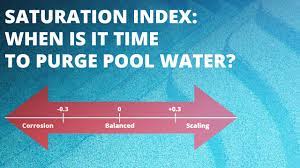Image Courtesy of https://sbcontrol.com/
Langelier Saturation Index: Understanding Pool Water Chemistry
Installing a swimming pool in your backyard is exciting. It adds a stylish place for relaxation and fun. With that being said, you first have to complete the process of having the pool installed. This involves excavation, pool tile selection, water supply, etc. Of course, the tough parts should be executed by professionals to ensure it is done correctly. Once the digging is done and the textures and tiles are in place, the swimming pool will be filled with water. This is a given; however, water’s relationship with pool textures is an actual science. As the pool owner, you will need to ensure they get along to solidify the lifespan of your new swimming pool.
Langelier Saturation Index
Image Courtesy of https://www.inyopools.com/
The relationship between water and its surroundings is calculated by something called the Langelier Saturation Index. What is the Langelier Saturation Index you might ask…
The Langelier Saturation Index calculates the level of saturation of calcium carbonate in water. The optimal level is 0.0 LSI, though a plus/minus of 0.3 is generally acceptable. A negative LSI indicates the water is undersaturated, which alerts the possibility of corrosion. A positive LSI, on the other hand, indicates oversaturated water, meaning the water could cause scaling (a buildup of inorganic materials found in pool shells).
Obviously, you want your swimming pool water as close to 0.0 LSI as possible. A 0.0 LSI means the water is at a perfect equilibrium. Furthermore, no corrosion and no scaling, resulting in a healthy and long-lasting swimming pool.
Calculating the Langelier Saturation Index
Hopefully we are not bringing back any nightmares from chemistry class, but the equation really is quite simple to calculate. It consists of six variables:
- pH
- Temperature (°F)
- Calcium Hardness (ppm)
- Alkalinity (ppm)
- Cyanuric Acid
- Total Dissolved Solids (ppm)
Equation: (pH) + (Temperature °F) + (Calcium Hardness) + [(Total Alkalinity) – (CYA correction factor @ current pH)] – (TDS factor) = LSI
(Equation per Orenda Technologies)
The point of the equation is to show you what exactly goes into the calculation and what all is measured to determine LSI. You won’t have to crunch the numbers yourself, but it is always good to have a base understanding so you know what questions to ask and so you can relate to an expert’s explanation when he/she advises of your pool’s LSI. Nothing is more frustrating than unknown technical terms being thrown at you, making your head spin.
Simply put, the closer to 0.0, the better. We don’t intend to confuse you; however, just like any product, you want to know its details and functions to ensure you use it correctly and can maintain it.
Contact Fujiwa Tiles
What is the Langelier Saturation Index?
We hope you have gained a good understanding of the Langelier Saturation Index. If you are looking to install a swimming pool, you will need swimming pool tiles. Fujiwa Tiles offers a vast selection of swimming pool and spa tiles with different types and unique designs. We also take sustainability and durability very seriously. We aim to create pool tiles that will have an ideal relationship with water to ensure quality and guarantee long-lasting swimming pool tiles.
Contact us today to pick out your pool tile!
FAQs (Frequently Asked Questions)
- What does a negative Langelier Saturation Index indicate?
A negative LSI suggests undersaturation, which can lead to corrosion of pool materials.
- Why is it important to maintain a balanced LSI?
Maintaining a balanced LSI prevents issues such as corrosion and scaling, ensuring the longevity of your pool.
- How often should I monitor the Langelier Saturation Index of my pool water?
It’s recommended to monitor LSI regularly, especially during temperature or chemical adjustments, to maintain optimal conditions.
- Can I calculate the Langelier Saturation Index myself?
While the equation can be complex, professionals can help calculate and interpret the LSI for your pool.
- What sets Fujiwa Tiles apart from other pool tile manufacturers?
Fujiwa Tiles offers a wide range of high-quality pool tiles designed for sustainability and durability, ensuring long-lasting beauty and functionality.



